stop start Alfa Romeo 166 2007 Owner handbook (in English)
[x] Cancel search | Manufacturer: ALFA ROMEO, Model Year: 2007, Model line: 166, Model: Alfa Romeo 166 2007Pages: 272, PDF Size: 4.17 MB
Page 80 of 272
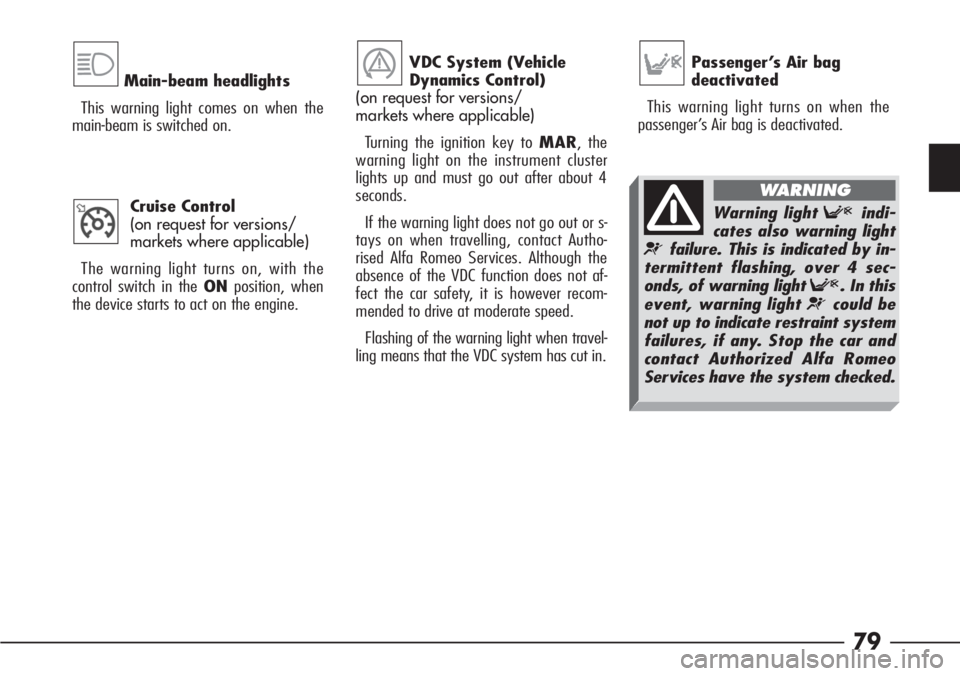
79
Main-beam headlights
This warning light comes on when the
main-beam is switched on.
Cruise Control
(on request for versions/
markets where applicable)
The warning light turns on, with the
control switch in the ONposition, when
the device starts to act on the engine.
1VDC System (Vehicle
Dynamics Control)
(on request for versions/
markets where applicable)
Turning the ignition key to MAR, the
warning light on the instrument cluster
lights up and must go out after about 4
seconds.
If the warning light does not go out or s-
tays on when travelling, contact Autho-
rised Alfa Romeo Services. Although the
absence of the VDC function does not af-
fect the car safety, it is however recom-
mended to drive at moderate speed.
Flashing of the warning light when travel-
ling means that the VDC system has cut in.
áPassenger’s Air bag
deactivated
This warning light turns on when the
passenger’s Air bag is deactivated.
Warning light Findi-
cates also warning light
¬failure. This is indicated by in-
termittent flashing, over 4 sec-
onds, of warning light F. In this
event, warning light ¬could be
not up to indicate restraint system
failures, if any. Stop the car and
contact Authorized Alfa Romeo
Services have the system checked.
WARNING
Page 92 of 272
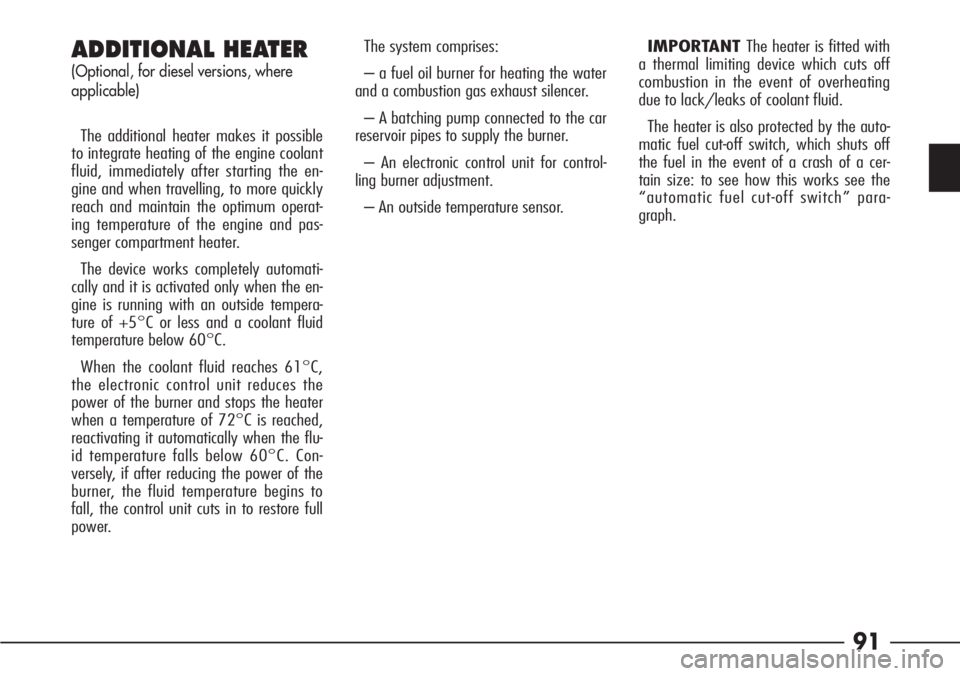
91
ADDITIONAL HEATER
(Optional, for diesel versions, where
applicable)
The additional heater makes it possible
to integrate heating of the engine coolant
fluid, immediately after starting the en-
gine and when travelling, to more quickly
reach and maintain the optimum operat-
ing temperature of the engine and pas-
senger compartment heater.
The device works completely automati-
cally and it is activated only when the en-
gine is running with an outside tempera-
ture of +5°C or less and a coolant fluid
temperature below 60°C.
When the coolant fluid reaches 61°C,
the electronic control unit reduces the
power of the burner and stops the heater
when a temperature of 72°C is reached,
reactivating it automatically when the flu-
id temperature falls below 60°C. Con-
versely, if after reducing the power of the
burner, the fluid temperature begins to
fall, the control unit cuts in to restore full
power.The system comprises:
– a fuel oil burner for heating the water
and a combustion gas exhaust silencer.
– A batching pump connected to the car
reservoir pipes to supply the burner.
– An electronic control unit for control-
ling burner adjustment.
– An outside temperature sensor.IMPORTANT The heater is fitted with
a thermal limiting device which cuts off
combustion in the event of overheating
due to lack/leaks of coolant fluid.
The heater is also protected by the auto-
matic fuel cut-off switch, which shuts off
the fuel in the event of a crash of a cer-
tain size: to see how this works see the
“automatic fuel cut-off switch” para-
graph.
Page 95 of 272
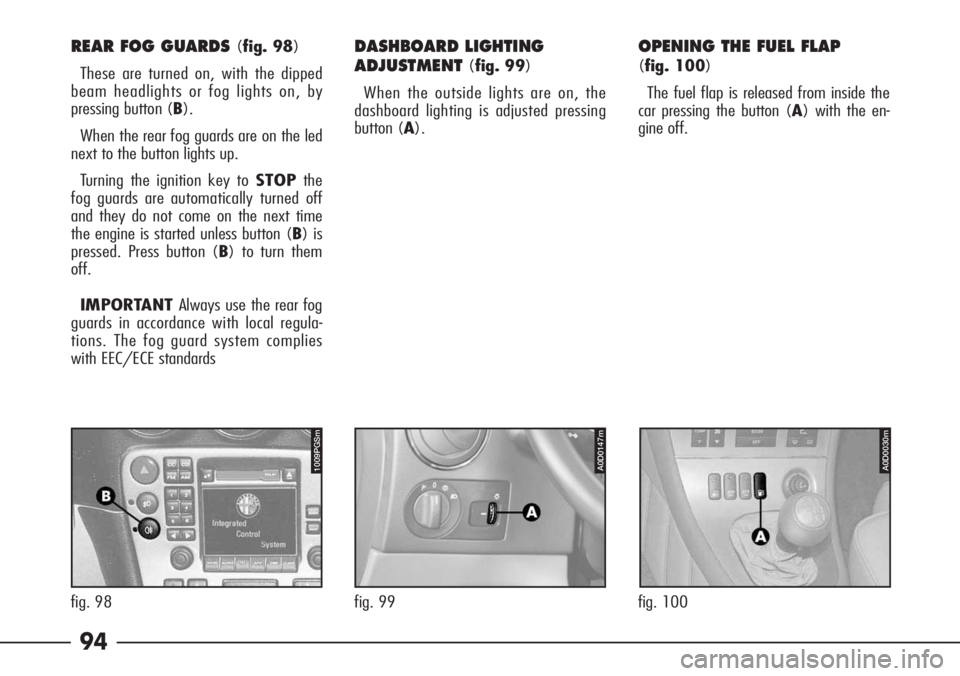
94
REAR FOG GUARDS (fig. 98)
These are turned on, with the dipped
beam headlights or fog lights on, by
pressing button (B).
When the rear fog guards are on the led
next to the button lights up.
Turning the ignition key to STOPthe
fog guards are automatically turned off
and they do not come on the next time
the engine is started unless button (B) is
pressed. Press button (B) to turn them
off.
IMPORTANT Always use the rear fog
guards in accordance with local regula-
tions. The fog guard system complies
with EEC/ECE standardsDASHBOARD LIGHTING
ADJUSTMENT
(fig. 99)
When the outside lights are on, the
dashboard lighting is adjusted pressing
button (A).
OPENING THE FUEL FLAP
(fig. 100)
The fuel flap is released from inside the
car pressing the button (A) with the en-
gine off.
A0D0147m
fig. 99
1009PGSm
fig. 98
fig. 100
A0D0030m
Page 128 of 272

127
AUTOMATIC FUEL CUT-OFF SWITCH
The car is equipped with a safety switch
which is triggered in the event of a crash
to interrupt the flow of fuel and stopping
the engine as a consequence. This also
prevents fuel leaks due to fuel lines
breaking.If no leaks or damages to electric de-
vices (e.g.: headlights) are found and the
car can be restarted, reactivate the fuel
cut-off switch. Follow the instructions giv-
en below.
If, after an accident, you
can smell petrol or see
that the fuel feed system is leak-
ing, do not reset the switches to
avoid the risk of fire.
WARNING
After the crash, remember to turn the ig-
nition key to STOPto prevent the bat-
tery running down.
Page 135 of 272

134
In addition to the notes
and specifications given
below we recommend
that, during the initial period, y-
ou do not drive to full vehicle
performance (for example exces-
sive acceleration, long journeys
at top speed, hard braking etc.).
STARTING
THE ENGINE
IMPORTANT The car is fitted with an
electronic engine lock device. if the en-
gine fails to start see “The Alfa Romeo
CODE system”.The ignition switch is fitted with a safety
device which obliges the driver to return
the ignition key to the STOPposition be-
fore repeating the starting operation if
the engine does not start immediately.
Similarly, when the engine is running,
the device prevents the key being moved
fromMARto the AVV position.
PROCEDURE FOR PETROL
ENGINES
With cold engine:
1) Engage the handbrake.
2) Ensure that the systems and electri-
cal devices, especially if they absorb high
quantities of energy (e.g. heated rear
windscreen), are switched off.
3) Set the gearshift lever to neutral and
fully depress the clutch without pressing
the accelerator.
4) Turn the ignition key to the AVV posi-
tion releasing it as soon as the engine starts.
Never leave the ignition
key in the MAR position
when the engine is
switched off.
5) If the engine does not start immedi-
ately, return the key to the STOPposi-
tion and repeat the operation
With hot engine:
1) Engage the handbrake.
2) Ensure that the systems and electri-
cal devices, especially if they absorb high
quantities of energy (e.g. heated rear
windscreen), are switched off.
3) Set the gearshift lever to neutral and
fully depress the clutch without pressing
the accelerator.
4) Turn the ignition key to the AVV posi-
tion releasing it as soon as the engine starts.
5) If the engine does not start immedi-
ately, return the key to the STOPposition
and repeat the procedure, slightly pressing
the accelerator pedal without pumping it.
Running the engine in
confined areas is ex-
tremely dangerous. The engine
consumes oxygen and produces
carbon monoxide which is a highly
toxic and lethal gas.
WARNING
Page 136 of 272
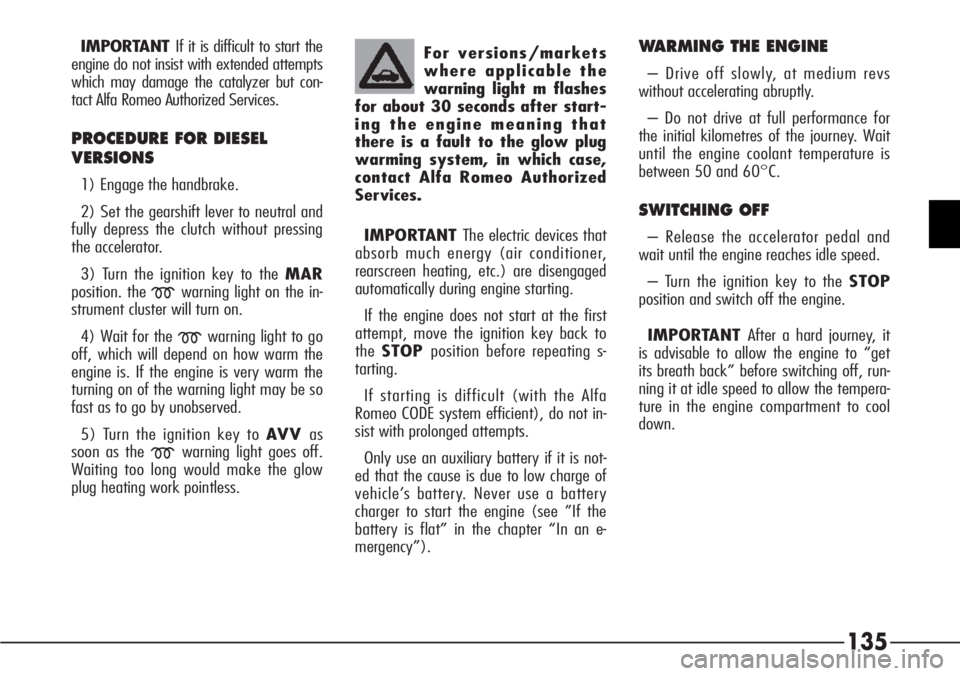
135
IMPORTANT If it is difficult to start the
engine do not insist with extended attempts
which may damage the catalyzer but con-
tact Alfa Romeo Authorized Services.
PROCEDURE FOR DIESEL
VERSIONS
1) Engage the handbrake.
2) Set the gearshift lever to neutral and
fully depress the clutch without pressing
the accelerator.
3) Turn the ignition key to the MAR
position. the
mwarning light on the in-
strument cluster will turn on.
4) Wait for the
mwarning light to go
off, which will depend on how warm the
engine is. If the engine is very warm the
turning on of the warning light may be so
fast as to go by unobserved.
5) Turn the ignition key to AVV as
soon as the
mwarning light goes off.
Waiting too long would make the glow
plug heating work pointless.IMPORTANT The electric devices that
absorb much energy (air conditioner,
rearscreen heating, etc.) are disengaged
automatically during engine starting.
If the engine does not start at the first
attempt, move the ignition key back to
theSTOPposition before repeating s-
tarting.
If starting is difficult (with the Alfa
Romeo CODE system efficient), do not in-
sist with prolonged attempts.
Only use an auxiliary battery if it is not-
ed that the cause is due to low charge of
vehicle’s battery. Never use a battery
charger to start the engine (see ”If the
battery is flat” in the chapter “In an e-
mergency”).
WARMING THE ENGINE
– Drive off slowly, at medium revs
without accelerating abruptly.
– Do not drive at full performance for
the initial kilometres of the journey. Wait
until the engine coolant temperature is
between 50 and 60°C.
SWITCHING OFF
– Release the accelerator pedal and
wait until the engine reaches idle speed.
– Turn the ignition key to the STOP
position and switch off the engine.
IMPORTANT After a hard journey, it
is advisable to allow the engine to “get
its breath back” before switching off, run-
ning it at idle speed to allow the tempera-
ture in the engine compartment to cool
down. For versions/markets
where applicable the
warning light m flashes
for about 30 seconds after start-
ing the engine meaning that
there is a fault to the glow plug
warming system, in which case,
contact Alfa Romeo Authorized
Services.
Page 143 of 272
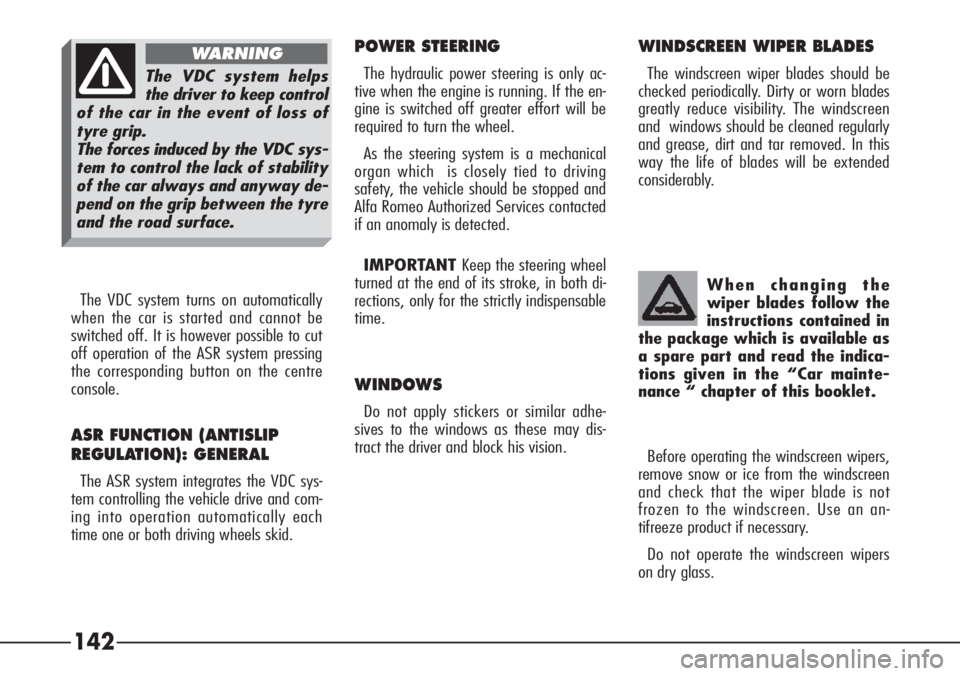
142
POWER STEERING
The hydraulic power steering is only ac-
tive when the engine is running. If the en-
gine is switched off greater effort will be
required to turn the wheel.
As the steering system is a mechanical
organ which is closely tied to driving
safety, the vehicle should be stopped and
Alfa Romeo Authorized Services contacted
if an anomaly is detected.
IMPORTANT Keep the steering wheel
turned at the end of its stroke, in both di-
rections, only for the strictly indispensable
time.
WINDOWS
Do not apply stickers or similar adhe-
sives to the windows as these may dis-
tract the driver and block his vision. The VDC system turns on automatically
when the car is started and cannot be
switched off. It is however possible to cut
off operation of the ASR system pressing
the corresponding button on the centre
console.
ASR FUNCTION (ANTISLIP
REGULATION): GENERAL
The ASR system integrates the VDC sys-
tem controlling the vehicle drive and com-
ing into operation automatically each
time one or both driving wheels skid.When changing the
wiper blades follow the
instructions contained in
the package which is available as
a spare part and read the indica-
tions given in the “Car mainte-
nance “ chapter of this booklet.
WINDSCREEN WIPER BLADES
The windscreen wiper blades should be
checked periodically. Dirty or worn blades
greatly reduce visibility. The windscreen
and windows should be cleaned regularly
and grease, dirt and tar removed. In this
way the life of blades will be extended
considerably.The VDC system helps
the driver to keep control
of the car in the event of loss of
tyre grip.
The forces induced by the VDC sys-
tem to control the lack of stability
of the car always and anyway de-
pend on the grip between the tyre
and the road surface.
WARNING
Before operating the windscreen wipers,
remove snow or ice from the windscreen
and check that the wiper blade is not
frozen to the windscreen. Use an an-
tifreeze product if necessary.
Do not operate the windscreen wipers
on dry glass.
Page 196 of 272

195
To avoid damaging the
vehicle’s electrical sys-
tem follow the manu-
facturer’s system instructions ac-
companying the jump leads. The
jump leads must be of a suffi-
cient cross-section and long
enough to ensure that the two
vehicles do not touch.
Never use a quick bat-
tery charger to start
the engine in an emer-
gency as this could damage the
electronic systems of your vehi-
cle, particularly the control units
which manage the starting and
supply functions.
The battery terminal
connecting and discon-
necting operations gen-
erate current that may cause
problems to the car’s electronic
systems. Therefore, this opera-
tion should be carried out by
skilled personnel.
At the end of the operation refit the bat-
tery cover.
IMPORTANT If the battery was com-
pletely drained, it may be necessary to
carry out the Alfa Romeo I.C.S. “self-
teaching” operation as follows:
– Let the engine idle to allow the bat-
tery to recharge and make sure it will
start next time.
– Switch the engine off.
– Turn the ignition key to MARand
leave it in this position for 30 seconds to
1 minute, then turn it to STOPfor about
5 to 10 seconds, after which the engine
can be started.
This starting procedure
must be carried out by
qualified personnel as incorrect op-
erations may provoke electrical
discharge of great intensity. The
liquid contained in the battery is
toxic and corrosive. Avoid contact
with skin and eyes.
Keep naked flame, and lighted cig-
arettes away from the battery. Do
not cause sparks.
WARNING
Page 222 of 272
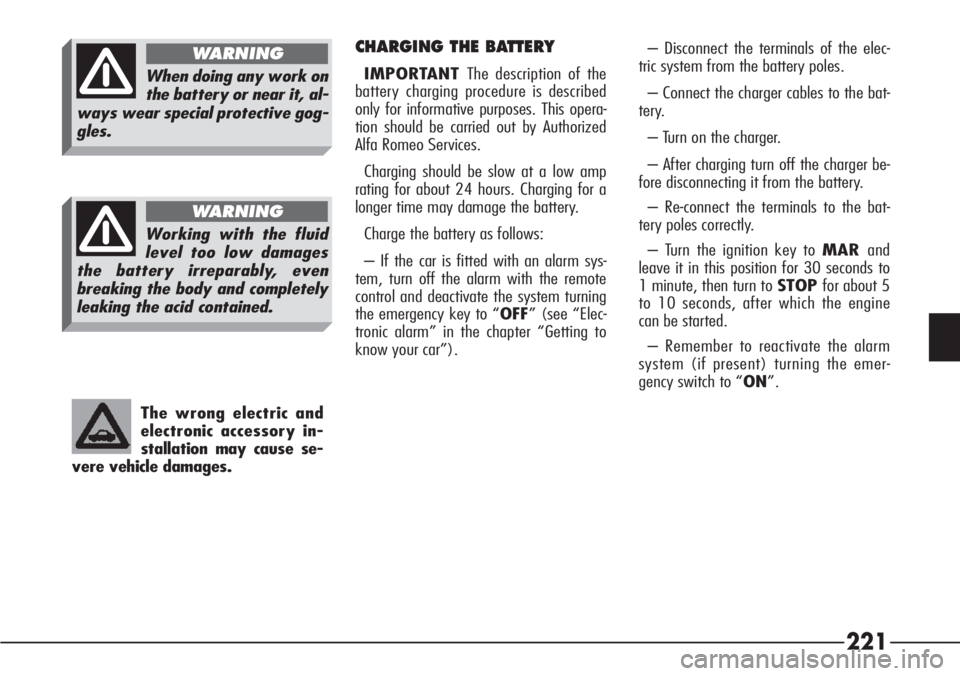
221
CHARGING THE BATTERY
IMPORTANT The description of the
battery charging procedure is described
only for informative purposes. This opera-
tion should be carried out by Authorized
Alfa Romeo Services.
Charging should be slow at a low amp
rating for about 24 hours. Charging for a
longer time may damage the battery.
Charge the battery as follows:
– If the car is fitted with an alarm sys-
tem, turn off the alarm with the remote
control and deactivate the system turning
the emergency key to “OFF” (see “Elec-
tronic alarm” in the chapter “Getting to
know your car”).– Disconnect the terminals of the elec-
tric system from the battery poles.
– Connect the charger cables to the bat-
tery.
– Turn on the charger.
– After charging turn off the charger be-
fore disconnecting it from the battery.
– Re-connect the terminals to the bat-
tery poles correctly.
– Turn the ignition key to MARand
leave it in this position for 30 seconds to
1 minute, then turn to STOPfor about 5
to 10 seconds, after which the engine
can be started.
– Remember to reactivate the alarm
system (if present) turning the emer-
gency switch to “ON”.
The wrong electric and
electronic accessory in-
stallation may cause se-
vere vehicle damages.When doing any work on
the battery or near it, al-
ways wear special protective gog-
gles.
Working with the fluid
level too low damages
the battery irreparably, even
breaking the body and completely
leaking the acid contained.
WARNING
WARNING
Page 223 of 272
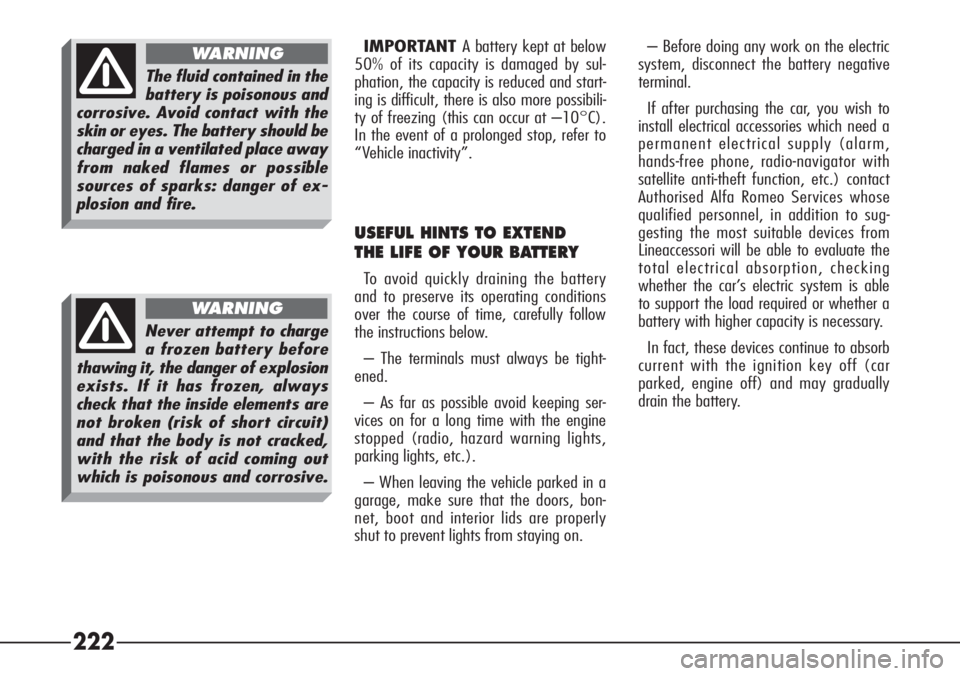
222
– Before doing any work on the electric
system, disconnect the battery negative
terminal.
If after purchasing the car, you wish to
install electrical accessories which need a
permanent electrical supply (alarm,
hands-free phone, radio-navigator with
satellite anti-theft function, etc.) contact
Authorised Alfa Romeo Services whose
qualified personnel, in addition to sug-
gesting the most suitable devices from
Lineaccessori will be able to evaluate the
total electrical absorption, checking
whether the car’s electric system is able
to support the load required or whether a
battery with higher capacity is necessary.
In fact, these devices continue to absorb
current with the ignition key off (car
parked, engine off) and may gradually
drain the battery. IMPORTANT A battery kept at below
50% of its capacity is damaged by sul-
phation, the capacity is reduced and start-
ing is difficult, there is also more possibili-
ty of freezing (this can occur at –10°C).
In the event of a prolonged stop, refer to
“Vehicle inactivity”.
USEFUL HINTS TO EXTEND
THE LIFE OF YOUR BATTERY
To avoid quickly draining the battery
and to preserve its operating conditions
over the course of time, carefully follow
the instructions below.
– The terminals must always be tight-
ened.
– As far as possible avoid keeping ser-
vices on for a long time with the engine
stopped (radio, hazard warning lights,
parking lights, etc.).
– When leaving the vehicle parked in a
garage, make sure that the doors, bon-
net, boot and interior lids are properly
shut to prevent lights from staying on.
The fluid contained in the
battery is poisonous and
corrosive. Avoid contact with the
skin or eyes. The battery should be
charged in a ventilated place away
from naked flames or possible
sources of sparks: danger of ex-
plosion and fire.
WARNING
Never attempt to charge
a frozen battery before
thawing it, the danger of explosion
exists. If it has frozen, always
check that the inside elements are
not broken (risk of short circuit)
and that the body is not cracked,
with the risk of acid coming out
which is poisonous and corrosive.
WARNING